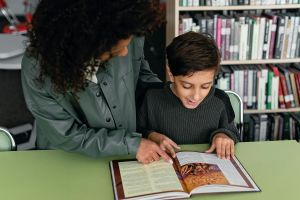When researching various definitions regarding reading conferences, the definition that appeared first was, “Conferring with students in reading is a one-on-one conversation between a teacher and student about their reading. It’s a way to assess student progress, provide feedback, and help students improve their reading skills.” Thank you, AI! Sure, that is a fine definition of a reading conference, but I, like Jennifer Seravallo, believe that conferring is where the magic happens! Jennifer Seravallo goes on to say, “It is the heartbeat of the literacy block. It’s an essential time for teachers to meet with students, tailor instruction to their individual goals, provide them with meaningful feedback, and grow relationships” (October 2019). Now that, to me, is the true definition of the reading conferences! While teachers are very well-intentioned, admittedly, if you ask any teacher, especially in grades 3-8, conferring with students about their reading would probably be at the bottom of their “things to do” list. Let’s face it, conferring is a daunting task, even for us veteran teachers. In this blog, I will break down the components in getting started to having quick, meaningful and informative reading conferences, with a focus on student progression.
“Conferring is where the magic happens!”
The first question that we need to ask is why reading conferences? According to John Hattie, conferring rates up there at about .52 in the zone of desired effects (2016). Conferring can also build reading stamina when students are encouraged to read what they are interested in reading. However, conferring with students promotes major angst among teachers. “How can I successfully manage all of my students and their reading levels along with the various books and genres?” Legitimate questions, but when we think about the foundation of the reading conference is focusing on the concept or standard that we are teaching at that time, conferring is less daunting. The key focus during a reading conference for teachers is to research what we are hearing our students say, decide what we need to do to help our students progress and teach or reteach the standard or concept.

So, how is this done? The teacher is an integral part in helping the student select an appropriate book, keeping the standards, as well as the student’s reading level and interests, in mind. The student must know, through teacher-directed mini lesson(s), what they need to focus on when they are reading their own piece of literature. Thus, what conferring looks like is the opportunity to have a conversation with the student about their book; asking questions with the goal of whether the student understands the standard or concept; then formulating a plan of what that student needs or what should be retaught. Conferring should not be a question or answer time but rather a conversation with the student about their book, once again, with the focus on knowing if the student can transfer the goal to what they are reading as well as understanding what they have read. How much time should a conference take in order for it to be meaningful to the student and teacher? Jennifer Seravallo suggests taking 5-7 minutes per student to conference is best; I would concur. My suggestion is to make sure that you have a timer beside you and set it to perhaps 5 minutes to begin, just so that you and your students can become acclimated to how the conference will flow. I would even suggest having a mini-lesson on reading conferences so that your students understand what is expected of them and how a reading conference will look.
“The key focus during a reading conference for teachers is to research what we are hearing our students say, decide what we need to do to help our students progress and teach or reteach the standard or concept.“
In order for reading conferences to be as beneficial as possible, the teacher should have a binder or digital space in which to keep record of their students’ conferences. Keeping a record of the date you conference, the reading goal, your observations, and next steps are beneficial for progression. Also, including a tool for tracking your meeting times is also helpful in ensuring equal time for all students.
Give your students and yourself time to get acclimated to having reading conferences. Remember to keep focused and reflect on their progress and yours! Make improvements, when needed, but most importantly, have fun and enjoy! This will be the very best time to get to know each of your students even better than before.
Resources
Jennifer Serravallo and Katie Wood Ray – A Teacher’s Guide to Reading Conferences, Heinemann, 2019
John Hattie-Visible Learning for Literacy, Grades K-12: Implementing the Practices That Work Best to Accelerate Student Learning,First Edition, Corwin Press, 2016
Patrick A. Allen – Conferring – The Keystone of Reader’s Workshop,Stenhouse, October 2023
Jennifer Serravallo – Research, Decide, Teach – Putting it All Together – Video, Heinemann Publishing · Feb 8, 2019
Nancy Atwell – In the Middle: Third Edition, Heinemann, 2015
Jennifer Serravallo Effective 5- to 7-Minute Reading Conferences, MiddleWeb, October 13, 2019 and Updated July 17, 2024
Please login or register to claim PGPs.
Alternatively, you may use the PGP Request Form if you prefer to not register an account.



